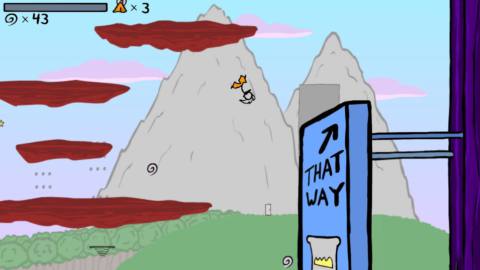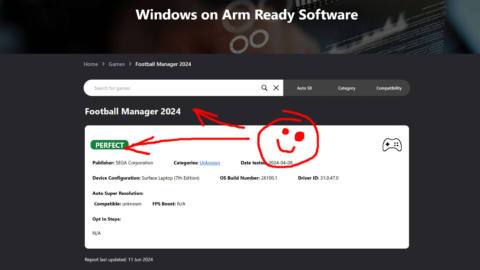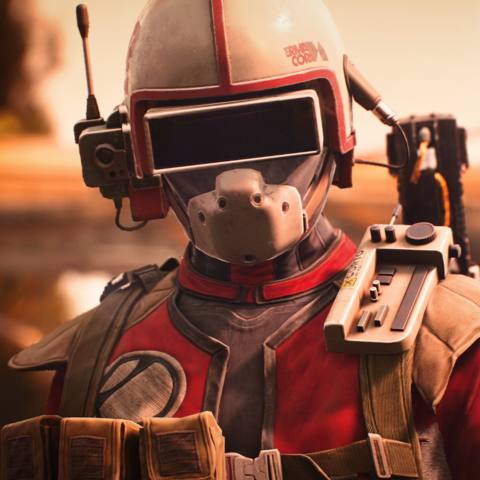Flash games are supposed to be janky. That's what hindsight tells me, anyway, even if it's at odds with my fuzzy childhood nostalgia. By that metric this remaster of one of my childhood staples, which arrived on Steam in February, truly isn't a Flash game. Moments into Fancy Pants Adventures: Classic Pack's first level, I was gliding on oil slicks and executing sweet, zig-zag wall jumps with snappy platforming controls. Sleek animations, tight physics, an utter absence of sophomoric shock humor; a rare, complete victory for fuzzy childhood nostalgia.
Under the surface, though, it's a bit of a nightmare.
“I'm contending with this crazy ancient platform that was never meant to make games, and was absolutely never meant to run in 4K,” says developer Brad Borne. “It was never meant to be downloaded. On top of that, I'm contending with myself: my old code that was literally just me figuring out how to do this stuff.”
If you were a kid in the 2000s, Flash games had the two things every game needed: They existed, and you could play them without asking for your parents' money. Many of them were haphazard, offensive, or straight-up unfinished, but a few managed to defy those amateur stereotypes. Fancy Pants wasn't the first Flash game to be outright good, but it rocketed to overnight popularity for a reason and helped prove that even though Flash's tools for game development were modest, clever programming could fit a surprising amount of sick wall jumping into a browser window. Like many other young Flash game makers, though, creator Brad Borne was literally figuring it out as he went along.
The ease of getting started in Adobe Flash is turning out to be a double-edged sword 18 years later. With the release of The Fancy Pants Adventures: Classic Pack into early access on Steam, he's wrangling three different Flash games—all of which were assembled at different points in the learning process—into a single program. The Classic Pack was originally scheduled for a January 15 release, but Borne's spent the start of 2024 crunching hard to get each game seamlessly transitioning into the others, as well as new content, without any game-breaking bugs surfacing.
“I guess I'm a bit of a masochist, I only get really excited about an idea if it sounds impossible. So it's all three games, same source files from forever ago, just updated. And then a shell that's just a slightly newer version of Flash that can at least talk to Steam,” he says. “It's like four different game engines and a shell all talking to each other. Getting one of them working on Steam is already its own big project.”
He's figuring it out as he goes, but in Borne's experience, that's well within the spirit of Flash development.
“I never really wanted to, but I learned to program because I wanted to make games. Everything that I learned, every trick and method and good practice, was all either because the program made me or because I needed to know it for the game … I had to finally, after so many years of school, learn how that stupid math stuff actually worked.”
Flash's ubiquity and hands-on development tools are why Borne felt solo game development was achievable in the first place, but it was still an unorthodox way to make games. Its humble beginnings as a rudimentary animation tool became increasingly apparent with each new ambition, and there were few learning tools for aspiring creators.
“You'd see a changelog: 'New thing: Flash Player can now stop using all of your CPU.' Yeah, but I'm making a game. I want it to use the CPU! If there's more CPU, I want to use it,” he remembers. “There's a reason when you open up a new Flash file, it defaults to 500 x 400 pixels and 12 frames a second. That's where [Adobe's] head was.
“The story of Flash is the accessibility. The story of a lot of Flash developers is, 'you probably shouldn't be able to do that.'”
Brushing the games up for a Steam release required a lot of “soul-searching” to find the balance between honoring nostalgia and updating the games to feel modern (and worth $10). His programming and animation skills have come a long way since 2006—but how different is too different?
Widescreen support, increased frame rates and new levels felt like a natural way to beef up the package, but as he sifted through his earliest source files, he found himself fighting the urge to let hindsight take the reins.
“I have to step back all these years laters and actually respect what I did. It's not just 'oh, this is trash, I didn't know what I was doing, I'm moving forward and my new game's gonna be so much better'. I want to actually understand and respect what the players saw when they played the earlier games,” Borne says. “You feel very naked when showing people artwork. There's a tendency to just want to move forward and bury your old stuff … at a certain point, as cynical as I am, it's almost disrespectful to the players that really love these games. Even the first game, warts and all.”

World 1 went live in 2006. In previous updates, Borne did away with some of his earliest animations in favor of their more polished counterparts from World 2. But with the Classic Pack, he's opted to reanimate the character animations from World 1 with the original files as a reference to preserve the games “as you remember them:”
“It's got its own identity that I had to hone in on, reanimating a lot of it. I had to figure out what that feeling was; the character's a bit more stretchy, the head gets elongated, the hair gets redrawn every frame so it's a bit wilder. So I could update the quality of the animation while keeping the soul of that game.”
Now that Fancy Pants is old enough to enlist, Borne's been able to watch a generation grow up playing and sharing browser games and pass that experience on to his own children, who've found digital stockpiles of their own to rifle through.
“My son was like, 'Dad, my friend told me to click on this website and play games in school,' and I'm like, 'Yeah, that's my boy,'” Borne laughs. “What did they think we were gonna do on computers?”
Of course, with the death of Flash, the original version of Fancy Pants is not playable in the same way. When his son remarked that his friends didn't believe his dad made games, it reminded him Fancy Pants isn't part of the browser game ecosystem like it used to be. Borne describes it all as bittersweet; while the plugin's passing was a monumental (if expected) loss, seeing the internet flood with strangers' memories of Flash's heyday was surreal.
“It's an amazing outpouring of love and respect. It's been a pretty long time since I've even had a release, but a Reddit post will come up that's just like, 'Hey, remember this guy?' or 'This game was my childhood' … I get super emotional about it,” Borne says. “That's the thing about Flash games, they're just deeply personal projects. People made the game that they wanted to play. The fact that people cared enough to also play that game, it's a hard thing to process.”
“I started hearing more and more that there was a market. People like the games enough that they just want them on their computer … even if there's no added value proposition, they connected with those games and they wanted to have them the way you want a Blu-Ray of a movie.”
Fancy Pants Adventures: Classic Pack debuted to a small—but Very Positive—98% thumbs up reception on Steam, and though I did encounter a few bugs playing it myself, I found the modernizations (widescreen and controller support especially) welcome and the slippery, momentum-minded platforming slick as ever. There's even a demo, fulfilling the two historic Flash obligations: It's there, and it's free.






